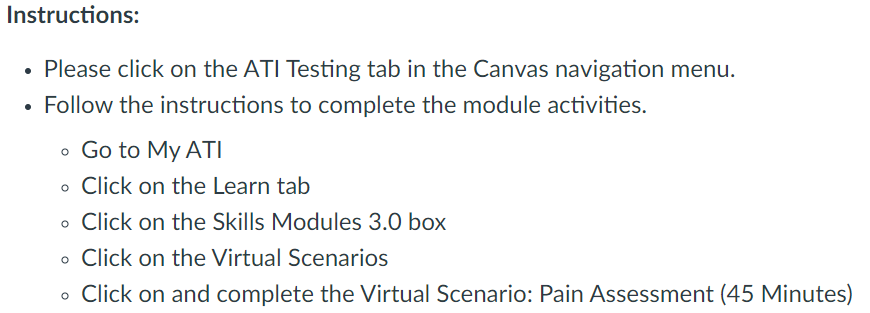NUR109 M6.5: ATI Skills Modules-Virtual Scenarios- Pain Assessment
Introduction:
In this scenario, we are focusing on pain assessment and management for the patient, Amy.
Privacy:
First and foremost, ensure Amy’s privacy is maintained during the assessment. Close doors or curtains, and speak in a quiet tone to protect her dignity.NUR109 M6.5: ATI Skills
Hand hygiene:
Practice good hand hygiene by washing your hands or using hand sanitizer to prevent the spread of infection.
Verify client identity using name and birthdate:
Confirm Amy’s identity to ensure you are providing care to the correct patient.NUR109 M6.5: ATI Skills
Introduce self:
Begin by introducing yourself, providing your name and explaining your role in Amy’s care.
Ask questions:
Now, let’s explore the questions you should ask Amy regarding her pain:
Question 1: What’s your pain on a scale of 1-10?NUR109 M6.5: ATI Skills
Answer 1: This question helps quantify the pain level and provides a baseline for pain assessment.
Question 2: What does your pain feel like?NUR109 M6.5: ATI Skills
Answer 2: Understanding the quality of pain (e.g., sharp, dull, burning) helps in identifying the source.
Question 3: Does your pain radiate?
Answer 3: This helps determine if the pain spreads to other areas.
Question 4: When did the pain get worse?NUR109 M6.5: ATI Skills
Answer 4: This identifies triggers or aggravating factors.
Question 5: Does the pain come and go, or is it constant?
Answer 5: Understanding the pain’s pattern helps in selecting appropriate interventions.
Question 6: What makes your pain better or worse?
Answer 6: Knowing what alleviates or exacerbates the pain guides pain management strategies.
Decreasing her pain:
Question 7: Are you allergic to any medications?
Answer 7: Understanding allergies is crucial to avoid adverse reactions.
What actions would you take to promote Amy’s comfort?
Answer 8: To promote comfort, consider offering extra pillows, closing window blinds for privacy and lighting control, adjusting the room temperature if necessary, and asking if Amy would like another blanket.
What medication would you give? Oxycodone
Answer 9: Oxycodone is a common pain medication prescribed for moderate to severe pain.
Which of the following are common side effects of oxycodone: Nausea, Dry mouth, Dizziness
Answer 10: Nausea, dry mouth, and dizziness are common side effects of oxycodone.
Check back in: 1 hour to 1 and a half hour
Answer 11: It’s essential to check back with Amy to evaluate the effectiveness of the pain medication within this time frame.
What should you do if Amy is sleeping:
Gently awaken Amy, Check for adverse effects, Ask if the patient needs help to go to the bathroom
Answer 12: You should gently awaken Amy to assess her pain level and check for any adverse effects of the medication. Additionally, inquire if she needs assistance with any other needs.
Talk:
Question 13: Can you tell me your pain level now?
Answer 13: This is to evaluate the pain level after administering medication and to monitor its effectiveness.
Try guided imagery:
Question 14: Tell me about your favorite place
Answer 14: Using guided imagery, ask Amy to describe her favorite place to help distract from pain and promote relaxation.
Close your eyes and breathe deeply:
Describe sounds, Describe scents, Describe feelings, Open your eyes
For notes:
Answer 15: Record that the patient responded well to oxycodone with no adverse effects. Additionally, document that the patient’s pain level improved from 6 to 4 on a scale of 0 to 10 following the guided meditation.
If you’re seeking assistance with ATI testing or preparing for the ATI TEAS exam, I encourage you to consider our service at fixmygpa.com. We provide expert guidance and resources to help you succeed in your ATI assessments and TEAS preparation, ensuring you achieve your academic and career goals.



